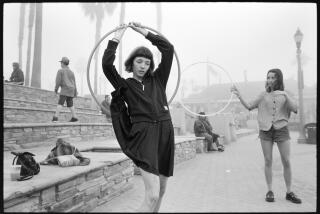PHOTOGRAPHY IN BRIEF : MAPPLETHORPE <i> Introduction by Arthur C. Danto (Random House: $125; 384 pp.) </i>
It’s not surprising to learn, as we do in this book’s rambling essay by Arthur C. Danto, that photographer Robert Mapplethorpe once planned on becoming a jeweler. There’s a bloodless precision to Mapplethorpe’s work, a shameless need to be beautiful and admired, that keeps his images resolutely on the surface like finely crafted, dazzling adornments. “I’m not interested in plain people,” Mapplethorpe once admitted, and his obsession with physical perfection takes on a fascistic dimension as one wades through what’s obviously intended as the definitive book on the controversial artist who died of AIDS in 1989.
The victim of an infamous episode of censorship on the part of the NEA, Mapplethorpe, his life, and work have been the subject of reams of press over the past few years, and one wonders what’s left to say about him that would warrant a book of this poundage (be warned: One must be in fairly good shape to lift this book). The answer to that question is that there really aren’t any stones left unturned in the Mapplethorpe department. Most of the images included here are fairly well known, and the Danto essay (which pivots on a comparison between Mapplethorpe and Garry Winogrand--why Winogrand!?) isn’t terribly insightful or well written. And finally, having perused the dozens of exquisitely reproduced plates, one can only conclude that although the issue Mapplethorpe came to represent--freedom of expression--is inarguably an important one, his work really wasn’t that extraordinary. In the end it was fortuitous for him that he became embroiled in the NEA controversy because it invested this body of work with more meaning than it had.
That controversy, of course, revolved around Mapplethorpe’s candid photographs documenting hard core S&M; practices in the gay community. A large body of that work is included here, as are in-depth looks at the other subjects that dominated his 18 years of work; portraits, self-portraits, figure studies, and still lifes of flowers and classical statuary.
One of the first things this comprehensive book reveals is that Mapplethorpe’s work was completely lacking in irony, a characteristic that sets him apart from other artists of his generation. Rather, Mapplethorpe approached his central subject--beauty--with profound seriousness and respect, and espoused a severe, classical style that led him to place his subjects against a neutral background, in shallow pictorial space and ostentatiously contrived lighting. The results are defiantly unsentimental and clinical.
Using this “clean” formalist approach to document the physical and psychological violence central to gay S&M; was perhaps the most brilliant idea Mapplethorpe ever had. These deeply disturbing photos--which Mapplethorpe himself described as pornographic--throw the underlying aggression intrinsic to all sexuality into high relief and challenge the viewer to define for himself what the limits of physical intimacy should be. Difficult though these images are to look at, this is surely Mapplethorpe’s most important work.
There isn’t a great deal of tenderness in Mapplethorpe’s portraiture--what it has instead is an intense degree of clarity--his highly touted still lifes of flowers are simply dull, as are his figure studies (his series on female body builder Lisa Lyon is particularly flat).
Mapplethorpe’s other great subjects were poet and musician Patti Smith (he had a unique talent for capturing her strange, earthy beauty) and himself--the self-portraits he took throughout his life are fascinating. A product of the hedonistic 1960s and ‘70s, Mapplethorpe was the very embodiment of the Dionysion gay sexuality that flowered after the gay community came out of the closet and went back underground with the advent of AIDS. Mapplethorpe was an unrepentant pleasure seeker who once said “given a choice between going to the party and photographing the party, I’d always rather go to the party”; that attitude is clearly part of a bygone era. In his final self-portrait he is obviously dying, but his eyes are still ablaze. It seems that his nerve never failed him, and ultimately that was at the heart of whatever greatness he possessed.
More to Read
Sign up for our Book Club newsletter
Get the latest news, events and more from the Los Angeles Times Book Club, and help us get L.A. reading and talking.
You may occasionally receive promotional content from the Los Angeles Times.







